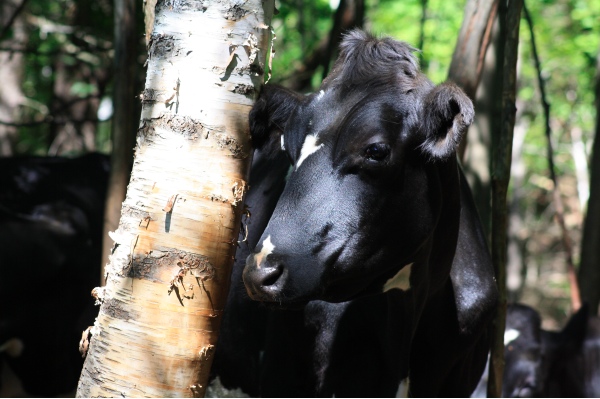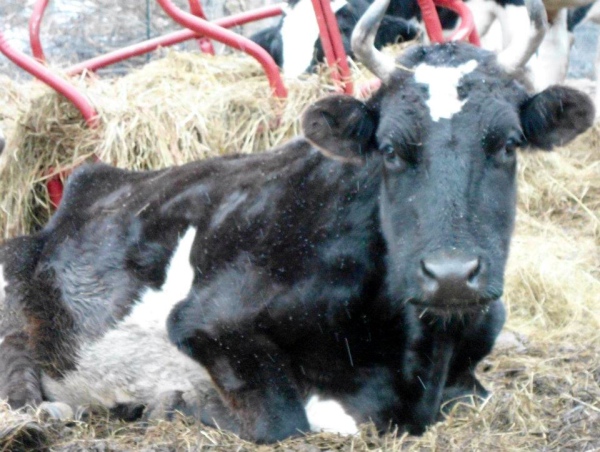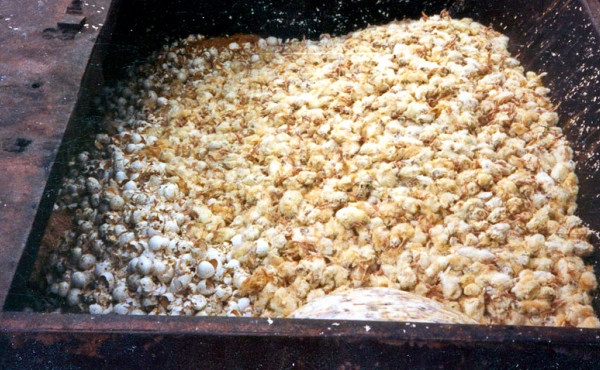Locavores and ex-vegetarians alike seem to share some common misconceptions about locally-sourced animal products. For example, they seem to believe that the environmental waste associated with meat, dairy, and egg production will be lower on a small-scale farm than on a factory farm or CAFO (confined animal feeding operation). While CAFOs do pollute their local environments much more intensely, this is due to the number of animals they confine, not to any greater per-animal rate of pollution. And, due to the very economies of scale that factory farms were designed to effect, factory farms use fewer resources per animal than do small-scale, supposedly sustainable, farms. This is not to say that there is anything good about factory farms, just to point out that small-scale animal agriculture is also environmentally unsound.

Milkshake, who was seized by authorities from a small-scale, slaughter-on-site farm of the sort beloved by locavores--his stall mate was already dead by the time the humane officers arrived.
But perhaps the most persistent fantasy soothing the minds of eaters of “happy meat” is the idea that small-scale or sustainable farming is inherently cruelty-free. To the contrary, small-scale farms routinely practice all of the cruelties inherent in the exploitation of animals for their flesh and body products. And, because of lack of oversight, small-scale farms may be even more likely than corporate farms to be the site of extreme abuse and neglect.
Factory Farming Atrocities
In their never-ending quest to maximize profit by minimizing inputs, factory farms routinely use cruel confinement devices such as battery cages and gestation crates. The extreme suffering caused by such factory farming practices cannot be denied and must not be ignored. We must also ask ourselves: How did these practices evolve?
Factory farming grew out of sustainable farming. To take just one example, it was a Delaware farm wife who invented the method of raising chickens now used by the corporate poultry industry. Hoping to make a bit more money for her family, she got the idea to raise large numbers of birds in close quarters, killing them while still very young in order to turn the quickest profit. The idea of battery cages came from the habit of keeping chickens caged in kitchens as a ready source of eggs. Almost all of the most egregious practices of factory farming are just common small-scale farming practices taken to the extreme.

As a calf, Jasper was tied to a tractor and left to starve by a small-scale dairy farmer who had no economic use for him. Both factory farms and small-scale farms judge animals only according to their usefulness to people.
“Happy Meat” Realities
Small-scale, sustainable animal agriculture begins with the same premises that underlies factory farming: Animals are commodities whose bodies belong to people rather than to themselves. Like factory farms, small-scale farms manipulate and murder animal bodies for profit. Like factory farms, small-scale farms break up animal families, impregnate females against their wills, separate siblings, and take children from their mothers—all so that the subset of elite people who can afford their products can enjoy the superficial sensory pleasures of particular flavors or textures.
Animal advocates sometimes use the deliberately oxymoronic term “happy meat” to refer to animal products –not only meat but also milk, eggs, wool, and other products– believed by their consumers to be “humane.” We understand that consumers really do believe that animals on small-scale, “sustainable,” or “locavore” farms are treated kindly. We appreciate the compassion that leads consumers to be willing to pay a premium in order to reduce suffering. At the same time, we know that those consumers have been tricked.

Blake, just after arrival from a small-scale dairy farm where she and three other cows nearly starved to death.
Let’s think about dairy. Like all other mammals (including humans) cows produce milk only after giving birth. The purpose of the milk is to feed the infant. All dairy farms —all dairy farms— impregnate cows (or goats or sheep) and then take their calves away from them. Removing infants from their mothers is the only way for people to obtain the milk of other animals.
As we would do if it were done to us, the mothers grieve mightily. They do anything they can to try to find and retrieve their children. Eventually, they give up and slump into depression and resignation that people mistake for cooperation as the people extract the milk for themselves, by hand or by machine. Eventually, the milk dries up and the cycle begins again: forced impregnation, birth, and removal of the child from the grieving mother.
Some farms do allow the mother “access” to her calf for some time before he or she is sold off to be meat or a dairy cow for somebody else. But, since barriers are used to prevent the calf from nursing (this may be a fence that prevents the two from touching or even a device worn by the calf to prevent nursing), this is not much less cruel than immediate removal. Mothers! Imagine yourself unable to touch your infant. Imagine somebody carrying your child away. Imagine somebody milking you. Can you truly say that any milk –no matter how it might be labeled– is cruelty free?

Male chicks in a dumpster behind a hatchery. Small-scale and backyard egg producers buy their hens from hatcheries, which typically drop unwanted male chicks into the trash to smother or starve.
As for eggs, it’s true that few if any animals suffer as intensely as hens in battery cages in egg factories. But this does not mean that “cage free” or even “free range” eggs are cruelty free. No regulations dictate what such terms mean. Hens in “cage free” facilities may be and often are crowded into barns or sheds with no access to the outdoors and little opportunity to move more than a few inches at a time. The access to outdoors offered by a “free range” egg facility may be and often is a tiny door to a tiny, dusty yard.
All hatcheries producing hens for egg facilities kill all the male chicks—often by such means as dropping them in dumpsters to smother or stave. All egg producers kill hens once they no longer produce enough eggs to make their upkeep profitable.

When she was seized by authorities from a small-scale beef farm, Luna (center) was nursing not only her own daughter Orchid (right) but also Oryx (left), whose own mother died due to the neglect they had endured.
Which brings us to meat. Meat is muscle. Muscle becomes progressively tougher and more stringy the more it is exercised. For meat to be palatable to people, the animal from whom the flesh comes must be fairly young. Animals raised and killed for meat have not, as many consumers of “happy meat” presume, led long and full lives. They are juveniles cut down in their prime. They did not want to die.
And the death, most likely, was both painful and terrifying. Small slaughterhouses and, especially, slaughter-on-site facilities have no real oversight to ensure that they abide by even the minimal standards set by the Humane Slaughter Act (which doesn’t even apply to poultry). There is absolutely no reason to assume that the cruelties that have been well documented at larger slaughterhouses do not also occur at smaller facilities. On slaughter-on-site facilities, animals also may experience the emotional anguish of having someone who they trusted turn around and kill them.
And the people who do this raising and killing, what of them? Do they, as many say, love the animals whose bodies they manipulate and slaughter for profit? What kind of “love” might that be? At best, there might be a kind of dissociated affection–or perhaps even the possessive love of the husband who believes he has the right to control, rape, and even kill his spouse–but, make no mistake: They must numb themselves to do what they do. That emotional numbness, or callousness, is the same as that felt by the slaughterhouse worker or the owner of a factory farm. In the end, to do what they do, they must see the animals as objects they rightfully own and control. That may be why so many cruelty cases prosecuted by authorities are not on factory farms but, rather, the very small-scale farms that so many consumers mistakenly believe to be cruelty free.
Proportions and Priorities
At present, 88% of “beef,” 95% of “pork,” 97% of eggs, 99% of turkey flesh, and 99.9% of chicken flesh is produced on factory farms. Those numbers, along with the extreme cruelty and aggregated environmental degradation associated with CAFOs, mean that the animal advocacy community has been and remains justified in focusing its attention on factory farms.
But that doesn’t mean we can neglect the animals who suffer and die on small-scale farms. Nor should we go along with the myth that meat, milk, or eggs ever could be “cruelty free.” We must especially be vigilant concerning the marketing of “happy meat,” which has tricked so many consumers –including some former vegans and vegetarians!– into thinking that choosing meat, dairy, or eggs could ever be sustainable or humane.




On the one “losing” hand, it is impossible to produce truly “happy” meat, whether in a CAFO or on a small family farm, because no matter how enriched the cages or how free the range, male hatchery chicks will always be killed at birth; male dairy calves will always be disposed of within the first year of their lives; dairy cows’ milk will always be diverted from their bovine babies to humans; piglets will always be castrated; steers will always be dehorned; family ties will always be abruptly and prematurely severed. In other words, no matter how many regulatory “wins” the welfarists chalk up, the suffering these nonhuman slaves endure is inevitable, making their final minutes, though torturous and terrifying, in some ways a relief.
On the other “losing” hand, even if welfarists were miraculously successful in forcing industry to eliminate all forms of “food” animal suffering (pretending for a moment that it were possible), they would then be put in the position of supporting the theft of happy lives — that is, snuffing out the joys of blessedly long-lasting mother-and-child relationships and other close friendships.
Thus, K OConnor’s friends who have a conscience will never have the pleasure of eating “humane” food that comes from animals. There is always suffering. There is always stealing. There is always slavery. There is always slaying. There is always speciesism.
When I realized and acted upon these facts a few years ago, I felt guiltless and free. I encourage K OConnor’s friends to awake to the truth, instead of deceiving themselves and living lies. They’ll be doing themselves, the earth and our innocent animal friends so much good!
I also appreciate the positive tone of this whole discussion. I think that goes a long way in effecting change among friends and family.
You’ll notice in my last comment that I thanked everyone for their comments, not stating whether I agreed with them. I’m gathering information and opinions from a number of sources, from all ‘sides’ of the issue. You seem to assume that I am in need of someone to direct me about who to listen to and who not to, and that you are the person to do it. I do not believe that this is the case.
Further, I find it very interesting that you support your response to the blog article with ‘facts’ of your own but no sources. Why should someone take your word for it and not the author’s? Personally, I think we should all be skeptical of claims made by any individual, organization or news outlet — and investigate the sources of information, if they are given.
Lastly, your statement that the association of spousal rape and murder with humanely raising animals should negate my acceptance of any further arguments from this group is your opinion, not a fact. I would guess it is based on your opinion that spousal rape and murder are not equivalent to animal suffering and death. At best, this is something of a philosophical question that could be debated with multiple arguments supporting the logic of one perspective of another. It is certainly far from a proven fact, as is your opinion that the comparison should negate any acceptance of comments from this forum.
Nonetheless, we agree that open discussion is vital, and so we do approve and respond to thoughtful expressions of disagreement that really are aimed at dialogue (rather than just sniping at us). I have left many of Geoff’s comments elsewhere standing, but the comment to which you refer was off-topic to the extreme, trying to get around the fact that comments on a previous post are closed by posting them here. If he had stuck to engaging in dialogue about what was written on this post, I would have let his comment stand. But by dragging in other topics, as well as slandering the sanctuary, he doomed that comment to the spam bin.
KOConnor – I would give you sources for my post but I don’t have it to refer to. I’m pretty sure one of them referred to “all cattle being dehorned” which is just not true. First, there are polled animals (hornless genome)even a breed known as Polled Herefords that have no horns. Also, some people keep horns on – especially in oxen. As I said, look at Bill and Lou. They had horns.
Another comment was in reference to dairy steers never living to one year of age. Dairy steers are raised and fed the same as beef steers which means they live past one year of age. In fact, there are CAFO’s that handle only Holsteins.
The comments above were directly related to the article about Happy Meat as were my original comments. BTW – that is a sarcastic term made up by those opposed to animal ag.
If you’re truly open-minded,give this a read “Meat: A Benign Extravagence by Simon Fairlie and published by Chelsea Green Publishing.
She writes that animal production and authentic sustainability are mutually exclusive.
Here’s the quote to which you were referring: On the one “losing” hand, it is impossible to produce truly “happy” meat, whether in a CAFO or on a small family farm, because no matter how enriched the cages or how free the range, male hatchery chicks will always be killed at birth; male dairy calves will always be disposed of within the first year of their lives; dairy cows’ milk will always be diverted from their bovine babies to humans; piglets will always be castrated; steers will always be dehorned; family ties will always be abruptly and prematurely severed. In other words, no matter how many regulatory “wins” the welfarists chalk up, the suffering these nonhuman slaves endure is inevitable, making their final minutes, though torturous and terrifying, in some ways a relief.
Of the six points I made, you disagreed with two of them. Even if I were to modify my words and put “almost” before “always” in reference to male dairy calves and steers, it wouldn’t change the fact that humans do to other species, for no good reason, what they would never want done to themselves. And what they are doing to those species is immoral. There is simply no moral justification (other than extreme and rare circumstances, which we’re not talking about here) for enslaving and exploiting and extinguishing the lives of sentient beings who belong to nonhuman species. None.
That said – There’s nothing I could ad except in the realm of human health issues – There are two outstanding youtube channels that provide a mountain of evidence about the benefits of a plant based diet – And the hazards of choosing otherwise:
Dr. Greger: http://www.youtube.com/user/NutritionFactsOrg/videos?view=0
The Vegetarian Society of Hawaii: http://www.youtube.com/user/vshvideo/videos?view=0
Happy animals? Those are the ones that walk around free and safe from harm — In sanctuaries such as VINE!